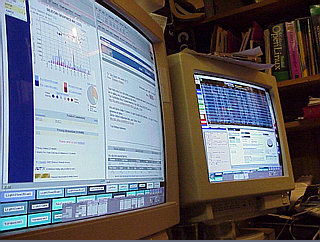
| Full XGA. | VGA 640x480. | 320x240. | 160x120. |
|---|
Tom's stuff on the simple and cheap way to be way productive.
The purpose of this page is to show a very productive way of implementing the FVWM window manager. The key element of this productivity is the enhanced ability to keep track of dozens of open applications with the FVWM Pager module. The arrangement of the pager to minimize the use of display pixel real-estate is also important. Another key element of productivity is no or very little degradation of the user's experience of system response.
I created this basic FVWM window layout over four years ago and I have not seen any other window manager that has features that can improve on the basic productivity of FVWM in managing dozens of open application windows with no degradation in system response. There are also other simple X applications like xfm or such that are easily configured to layer on the supposed simpler gui application navigation. But alas the world wants the kluge look and feel of the borg. Did fvwm originally get a bad rap from Redhat's decision long ago to make fvwm95 the default window manager for a couple of years?
Note: read this carefully... For each photo I've created a series of different size images.
As it makes sense I'll provide pointers to different size pics. I've done this to be nice to the bandwidth challenged. I happen to be lucky in that I live in an area
that is serviced by Charter Communications and I have a cable modem. Download at 512k and upload at 128k, connected 100% of the time and what it really means
is that XGA pics pointed to on this page download in a three to five seconds.
XGA pics range in size from 150 to 200k.
VGA pics range in size from 60 to 100k.
320x240 pics range in size from 30 to 50k.
160x120 pics range in size from 8 to 12k.
Thumb-nails point to the XGA size.
For reference, this is a 320x240 pic of my dual screen Linux system.

| Full XGA. | VGA 640x480. | 320x240. | 160x120. |
|---|
About this system.
Hardware.
A PS/2 THREE BUTTON MOUSE
Circa 1996? Intel Venus atx motherboard Ppro 180 clocked at 200 Mhz
128 meg of dram.
15 gig IBM deskstor ide hard-disk.
2 Matrox Millennium 8 meg video cards.
Floppy and 4x ide cdrom.
The hardware is boxed in a 30 dollar no-name atx mini tower.
A "3" BUTTON MOUSE
Monitors
Display :0.0 is a Hitachi Superscan Pro 21 1600x1200
Display :0.1 is a Tatung CM-17 MBR 1280x1024
Software: Red Hat Linux release 5.2 (Apollo) Kernel 2.0.36 on an i686
binaries are ELF 32-bit LSB executable, Intel 80386, version 1, dynamically linked, stripped
GUI:
Xserver AcceleratedX multi-head V4.1
Window Manager fvwm-1.24r-15
A THREE BUTTON MOUSE
User experience, the key to understanding the limits of unlimited productivity.
My RULE: If a resource request takes longer than a second on average the system is not unlimited productive.
The system that I use has 95% of the time less than one second response or active
availability when I shift between applications. It does not matter if the application
is on the current desk or I switch to another desk and select
an application. So my user experience tells me that more memory would reduce the likely hood
of 1 in 20 times of a 2 to 5 second delay in switching the current
active application caused by swap delays. A faster CPU or video card would not be effective.
So anyway I can have open 30 or 40 of my applicationss in addition
to the 40 or so system processes and have a very good user experience.
Well that's nice but how do you keep track of 40 open windows? Well why would you want to have 40 open windows or apps? I'm not going to discuss why but this is how my FVWM configuration allows me to keep track of and manage dozens of open applications. The FVWM pager module allow multiple desk-tops of n by n desks. Most default FVWM init files show only single Desktop with 2xn desks. I setup multiple desk-tops of 1x1 or 2x1 desks. This is a pic of display :0.1.
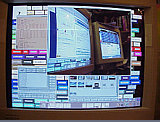
| Full XGA. | VGA 640x480. | 320x240. | 160x120. |
|---|

| Full XGA. | VGA 640x480. | 320x240. | 160x120. |
|---|
NO it's
A THREE BUTTON MOUSE
Now I'm going to describe a few of the wonderful things that a THREE BUTTON MOUSE empowers.
I can highlight any text in any app window and move to any other app window and with the center button paste the text. As long as I leave the text highlited I paste anywhere as long as I like.
I use this to cut an paste between different email's and web pages and with aliases I put common used text, personal info into an xterm and paste to fill out endless web forms.
I also can use the center mouse button to drag apps across desk-tops so I can place any windows side by side instantly.
I also can use the right mouse button raise and lower windows.
This is a pointer to the fvwmrc file used to create this window layout. Their are all kinds of ways to hot mouse/key all kinds of actions.
One other modules I use is tkgoodstuff that creates a button bar. This is in the lower right corner of my desktop. I only have one application, xv as a button. The other buttons are remote logins to other systems that I use. I touch a button and I am logged into another system. I use different colors as a visual clue as to what system a specific application is running on.
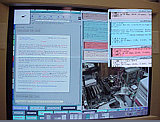
| Full XGA. | VGA 640x480. | 320x240. | 160x120. |
|---|
Now any application can be started with a button and FVWM has standard pull-down multilevel menu scheme.
So I always find that when I look at other window managers
I end up thinking, lousy default layout and resource pig city, well it's pretti and cute but
Some other pics of my system and systems.
Ugly server is a pic of computer "square" that's a naked venus mother board running Linux. As I type this this system has been up.
7:46pm up 19 days, 20:07, Red Hat Linux release 6.0 (Hedwig)
Also is the lower right hand corner is system 4t5.
7:48pm up 25 days, 6:19, Slackware kernel 2.0.35
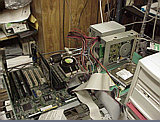
| Full XGA. | VGA 640x480. | 320x240. | 160x120. |
|---|
Side by Side Netscape 4.xx browser windows showing investment information.
Desktop 4, desk 1 of 2.
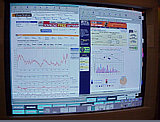
| Full XGA. | VGA 640x480. | 320x240. | 160x120. |
|---|
Side by Side Netscape 3.xx browser windows showing mail window an browser at Silicon Investor.
Desktop 2, desk 1 of 2.
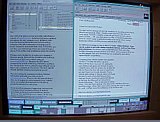
| Full XGA. | VGA 640x480. | 320x240. | 160x120. |
|---|
 Comments or suggestions tom@watman.com
Comments or suggestions tom@watman.com
Does all this only apply to Multi Display computers?
All of the benefits of FVWM will work on a single display system.
In fact about 10 meg of memory would be freed with a single head Xserver.
Do I really need AcelleratedX server from xig?
FVWM is the fastest and leanest of all window managers. It will work with Xfree86.
AccereratedX is the fastest xserver and the single display version is less than 100 bucks.
I would still use AcceleratedX for single head even if Xfree86 were as fast as the xig setup is way more simple than XFree86.
I also believe that their are no/fewer bugs more consistently for all video cards supported by xig.
I have in past used combination of xig that were well outside of normal use and have never had any problems.
To see Tom's other Wacky multi display Pooters.
To see Tom's four eyes Trading station.
What does the .fvwmrc file look like to create this FVWM layout. The .fvwmrc
How do you make different size images with the image magic tools. The script makeglassandmini.com
What do the references to systems square, 4t5 mean? The theme I used to create system names in my local domain is based on angle names. acute obtuse obleak 4t5 1at square ....
And last but most important. HOW do you make fvwm the default window manager?
Well on redhat as root you edit, vi /etc/X11/xinit/xinitrc
rpm -qa |grep fvwm will tell if fvwm-1.24r-15 is installed.
or ls -al /usr/X11R6/bin/fvwm
Also copy place my .fvwmrc in your home directory.
Now remember the file on my web-server is named fvwmrc and you need to save/name it locally .fvwmrc
I usually save /etc/X11/xinit/xinitrc to /etc/X11/xinit/xinitrc.orig
Then I edit and hard code exec /usr/X11R6/bin/fvwm in the xinitrc file.
Other rambling... What's this stuff on a three button mouse? Well a one button mouse has one degree of freedom and thus you are stuck on a line using software developed by folks with a vision stuck on the line. Hey an apple falls on your head not far from the tree. A two botton mouse has two degrees of freedom and so one uses software developed on a flat plane of thought. A three button mouse has three degrees of freedom and clever folks think about solutions from every angle and high and low. Well common sense thus suggest that a three buttom mouse has volumes more capability.
Skipper Tom, Team Bread and all the crew of Sea Scout Ship 110: are looking for mates interested in....